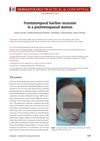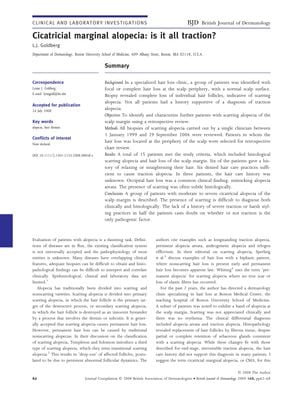TLDR Traction may not be the only cause of cicatricial marginal alopecia.
In the 2009 study, Dr. Lynne J. Goldberg evaluated 15 patients with cicatricial marginal alopecia (CMA), a type of scarring hair loss at the scalp margin. The study, which reviewed biopsies from 1999 to 2006, found that not all patients had a history of hair care practices leading to traction alopecia, with six denying such practices and three having an unknown hair care history. Histological analysis showed a loss of hair follicles and retention of sebaceous glands, with an average of 7.8 hair follicles per 4-mm punch biopsy, significantly lower than the normal range of 21 to 38. The study concluded that traction may not be the only cause of CMA and highlighted the need for further research into the mechanisms of follicular loss and the role of stem cell depletion in scarring alopecia. Clinicians were advised to consider CMA in cases of band-like hair loss at the scalp periphery, even without a history of traction alopecia.
15 citations
,
February 2006 in “Journal of Investigative Dermatology” More research is needed to understand and treat cicatricial alopecias.
 44 citations
,
July 2005 in “Aesthetic Plastic Surgery”
44 citations
,
July 2005 in “Aesthetic Plastic Surgery” Hair transplantation successfully treated a woman's hair loss caused by a tight ponytail.
57 citations
,
August 1999 in “Archives of dermatology” Hair follicles grow hair and release it through the skin.
 16 citations
,
January 2013 in “Indian Journal of Dermatology, Venereology and Leprology”
16 citations
,
January 2013 in “Indian Journal of Dermatology, Venereology and Leprology” New treatments and early diagnosis methods for permanent hair loss due to scar tissue are important for managing its psychological effects.
 5 citations
,
October 2012 in “Expert Review of Dermatology”
5 citations
,
October 2012 in “Expert Review of Dermatology” Trichoscopy is a useful tool for diagnosing hair and scalp diseases without needing skin biopsies.
 33 citations
,
January 2010 in “Case reports in dermatology”
33 citations
,
January 2010 in “Case reports in dermatology” Dermoscopy helps diagnose frontal fibrosing alopecia by distinguishing it from other hair loss conditions.
 3 citations
,
April 2015 in “Dermatology practical & conceptual”
3 citations
,
April 2015 in “Dermatology practical & conceptual” Postmenopausal women can experience hairline recession, affecting their quality of life, and more research is needed for treatments.

Different scalp and hair disorders are more common in certain ethnic groups, with the most common being androgenetic alopecia, which is treated with medications like minoxidil and finasteride.






